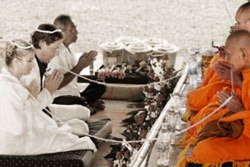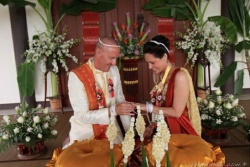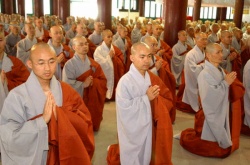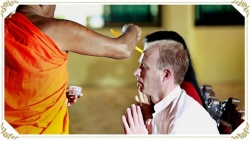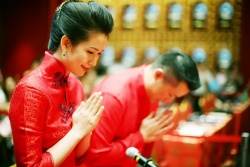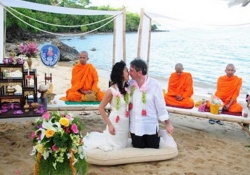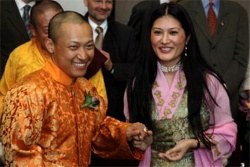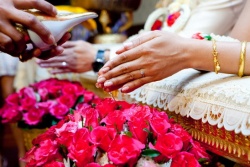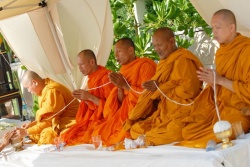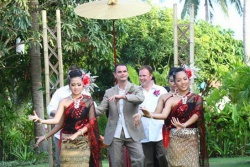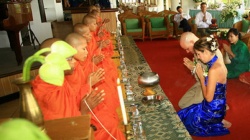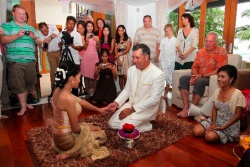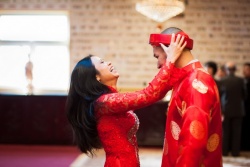Thai Buddhist Wedding ceremony
Thai Buddhist Wedding on Koh Samui
For couples deciding to have their wedding in Thailand, the opportunity to be blessed by Buddhist monks should not be missed.
Buddhism is as much a philosophy as it is a religion. The open minded and tolerant nature of the faith allows the clergy to perform wedding rituals for those who know little about it; and even those who have never practiced the religion.
Depending on the wishes of the couple, 5, 7 or 9 orange robed monks will be invited to perform the ceremony. Incenses and an image of the Lord Buddha create an atmosphere of calm and tranquility, with all those attending sat facing the monks.
Led by the senior most clergy, prayers chanted in the ancient Pali language begin the ceremony and bestow blessings on the couple; who kneel close together in front of the monks with their hands in the traditional wai position - a sign of respect and supplication.
The monks will always be facing towards the West.
The senior monk will drape sacred string around the heads of the couple to symbolize their committment to one another, and he sprinkles them with holy water from a leafy branch. Gifts and small donations are presented by the couple to the monks, after which there are more prayers. The ceremony usually lasts for 30 minutes, and conveys an almost hypnotic feeling on all present.
Water Blessing Ceremony
After the monks depart, the bride and groom kneel side by side on a special pedestal to give their guests the opportunity to bestow their invididual blessings. This they do, one by one, by gently pouring water over the hands of the couple. The water passes through the hands of the bride and groom and into a flower filled vessel beneath.
A Buddhist wedding ceremony is as serene and evocative an occasion as one could wish for, and provides the feeling that one's union is welcomed, and entirely in place, in this exotic land.
Couples having a Buddhist Wedding will be invited to Faraway for a rehearsal a day or two before the event. During this meeting, not only you will be taught the dos and don'ts of a Buddhist ceremony; how to sit, how to Wai and how to approach the monks, but we will also explain the order of service.
Pre-Wedding Rituals :
The Buddhists are strict conventionalist in the matters of ceremonies and the weddings are no exception. The augmentation of the pre-wedding rituals is marked by the formality of asking the bride's family for their assent by the groom's family. The propitious day for this is decided by the monk called Lama. This is followed by the betrothal ritual. The lama recites the prayers and then a concoction called the madyan, which is considered a religious drink, is served to the guests. The astrologer or the monk stipulates the auspicious day for the wedding.
The Wedding :
In the early morning, the bride's and the groom's families arrive at the temple. The groom's family carries a procession of trays containing fruits, wine, traditional cake, tea, meat, and most importantly jewelry that the bride will get as dowry. The trays have to be either six or nine in number, never seven or eight as these are considered unlucky numbers. One of the trays also contains a pair of candles which are lit either by the bride and the groom or their parents; the tradition varies with places and countries. The lighting up of the two candles symbolizes the union of the two families.
Before a specially erected shrine and the image of Lord Buddha, the couple and the assembly recite a procession hymns- Vandana, Tisarana and Pancasila. The candles and the incense sticks are lit before the image of Lord Buddha and flowers are offered. Next, the bride and the groom recite the traditional undertakings as inscribed in Sigilovdda Sutta. The groom says:
"Towards my wife I undertake to love and respect her, be kind and considerate, be faithful, delegate domestic management, present gifts to please her."
The bride speaks thus:
"Towards my husband I undertake to perform my household duties efficiently, be hospitable to my in-laws and friends of my husband, be faithful, protect and invest our earnings, discharge my responsibilities lovingly and fastidiously."
The wedding ceremony is concluded with the recital of Mangal Sutta and Jayamangala Gatha as a blessing for the newlyweds.
There are many different aspects to a traditional Thai wedding, but not all of these traditions are maintained today. Consequently, there can be many variations in the basic ceremony which can be as elaborate or as simple as the wedding couple (and their families) want to make it. Traditions vary in different parts of Thailand so for instance a Thai wedding in the south of Thailand (for example, Phuket) can be very different to a wedding in the north of Thailand (such as Chiang Mai). For marriages in some rural areas and Thai villages ‘upcountry’, there is more chance that many of the old customs, such as ‘preparing the bridal bed’ (see below), will be incorporated in the wedding ceremony. The Thai wedding ceremony is essentially non-religious despite the fact that monks may be present. No vows are made but there is a large amount of symbolism to ensure good luck for the newly-weds.
Choosing the Date
To ensure a happy and prosperous marriage, the couple should marry at an auspicious time and date. This isn’t taken lightly and astrologers may be consulted to see if the stars are compatible.
Wedding Invitations
Some parts of the wedding day, such as the blessing by monks in the morning, will only be attended by relatives and close friends of the bride and groom. Wedding invitations list the times that each of the most important ceremonies start. The timing of the Buddhist ceremony is set to ensure good luck and will commence at an auspicious time such as 09.09 (9 is a lucky number in Thailand). Thai people aren’t generally renowned for their punctuality, but they will pay particular attention to wedding times to ensure good luck for the couple being married. When it comes to the evening feast or wedding reception, invitations are more casual and a verbal invite can suffice.
Engagement Ceremony
Not surprisingly, the engagement ceremony must take place before the wedding although for practicality and to save money, some couples may hold it on the same day as the wedding (see khan maak procession below).
Paying Homage to the Bride’s Ancestors
This is a Buddhist ceremony that usually takes place the night before the wedding. It’s quite a simple ceremony and the couple wear everyday clothes, but the principle is that the couple are honouring the bride’s ancestors.
Making Merit
Making merit is important to Buddhists and it is particularly important on special occasions such as weddings. Inviting monks to the ceremony ensures merit because donations will be made to the monks. Another way that couples can make merit is by granting an animal its freedom. This is typically done by releasing a bird from a cage, or releasing a fish or turtle back into the water.
For Thai Buddhists, it is widely believed that donating a merit gift (i.e.money) to the local wat (temple) will ensure a lifetime of love for the marriage. If the groom makes a generous donation to the local wat in the name of the bride’s parents, it shows great respect for both the bride and her family.
Buddhist Blessing and Merit Making
You don’t have to be Buddhist to partake in the ceremony and, in fact, many Western couples also elect to have a Buddhist wedding ceremony when they marry in Thailand. It is important to note that although monks may be present during part of the wedding day, a Thai wedding is essentially a non-religious affair and will usually take place in a private home belonging to a relation of either the bride or groom as opposed to a wat or temple. If monks are invited to attend the ceremony it will be to bless the couple and enable them to make merit. Performing a Buddhist ceremony does not in itself grant legal status on the marriage. For that to happen, the marriage needs to be registered at the Amphur Office.
The wedding day morning will normally begin early (approximately 6-7a.m.) with monks arriving to visit the couple who are to be married. The monks will chant and say prayers whilst a lit candle is placed in a bowl of water. This lustral water is then used later to bless the couple. A bowl of white paste may also be blessed which will be used later to anoint the foreheads of the bride and groom.
The wedding couple and their relatives offer food to the monks before leaving the room to allow the monks to eat. Nobody else is permitted to eat until the monks have finished their meal. After their meal, the monks will begin their chants again and the senior monk will bless the couple, and everybody present, with holy water. The monks then return to the temple. In some instances, the couple may go to the temple rather than have the monks visit them, but donations and food will still be offered to the monks. If monks are present (there can be 3, 5, 7 or 9 monks), trays are usually placed in front of them to receive the envelopes containing the donations. Depending on how the wedding day has been arranged, the khan maak and doors ceremony often follows next.
Khan Maak Procession
Traditionally in Thai culture, the family of the groom discuss with the family of the bride how much dowry (‘sinsod’) should be paid. Once this is agreed, the engagement can take place which involves an offering of gold and gifts for the bride and her family. The groom and his family form a procession to take the ‘khan maak man’ (‘items for engagement’) on special trays to the family of the bride. In olden times it used to be that the procession would leave from the groom’s house and walk to to the bride’s house, but modern life has changed things slightly. Nowadays, the khan maak procession often takes place on the same day as the wedding itself and starts just around the corner from where the bride is staying. The procession is a lot of fun and is accompanied by musicians playing traditional long drums as the entourage dances its way to the bride’s house. When the groom’s family reach the bride’s home the way may be blocked by symbolic doors or gates.
This ceremony is what the Thais call ‘sanuk’ with plenty of laughter and frivolity most of which comes at the expense of the groom as he is teased and gently ribbed by the bride’s family. The bride remains inside the house when the khan maak procession arrives. To make sure that the groom is worthy and financially able to take care of his bride, he must be able to open the symbolic doors or gates. The number of doors or gates can vary from region to region, but typically there is a gold and silver gate represented by a gold or silver belt or ribbon which is held by two female members of the bride’s family. The silver gate is known in Thai as ‘pratoo ngoen’ and the gold gate as ‘pratoo tong’. To open the gate the groom must be able to provide a ‘key’. This key comes in the form of an envelope with money inside. The groom may be given a hard time as the gate guardians joke and tell him the money isn’t enough to gain access. As he reaches each gate the amount asked for will be more and there is lots of cheering as each gate is successfully opened. Depending on circumstances it can either be the groom or his father that hands over the money envelopes to the gate guardians.
Once the gates have been successfully negotiated, the groom’s family will present gifts to the bride’s family which traditionally include banana and sugar plants. In years gone by, the plants would be nurtured at the bride’s house and when the couple had their first child the plants would be there to provide nutrition for the baby. As well as the plants, the khan maak procession will bring food which will be laid out for the ancestors who have passed away. This demonstrates that the dead ancestors have not been forgotten and that they are part of the joyous occasion. Gifts will also be handed to the bride and her family (usually gold chains or necklaces) and the dowry (‘sinsod’) will be presented for inspection.
Sai Monkhon
The next part of the wedding ceremony is usually conducted by a senior elder who may be a member of the bride’s family or a respected member of the community. During the wedding ceremony, the couple wear traditional Thai clothing and kneel in front of the senior elder, with the groom on the right. The couple ‘wai’ as specially prepared white thread, ‘sai monkhon’, is looped and used to link together the bride’s and the groom’s heads. It is symbolic that the thread forms two circles which whilst linked, also remain independent. This indicates that the couple’s destinies are linked, but individual identity is retained. The circle is also symbolic because of its continuity and the fact that merit can be carried around in the circle.The senior elder then pours sacred water over the hands of the couple. Bowls of flowers are placed underneath the hands to catch the water. The guests then bless the couple by also pouring water over the hands of the couple in the ‘rod nam sang’ ceremony.
Shell Ceremony – ‘Rod Nam Sang’
The bride and groom wear garlands round their neck and kneel and wai whilst the elder says a few words and anoints them on the forehead. A conch shell (known in Thai as ‘sang’) is filled with holy water and is used by each guest to gently pour over the hands of the newly-weds (‘rod nam’ means to soak with water). Each guest places a gift, usually an envelope of money, in a basket. The amount given is supposed to depend on social status. In return the guest may receive a small memento of the wedding day before the group photos are then taken.
White Thread Ceremony – ‘Phiti Bai Sri Su Kwan’
The newly-weds sit next to each other whilst an old and wise man says auspicious things and blesses the wedding. White threads are linked to the wrists and soaked with holy water. The thread is then torn on the side until it breaks and whoever has the longest piece is supposed to be the one whose love is deepest.
Sai Sin
Lots of relatives, friends and well-wishers will tie pieces of white string, ‘sai sin’, around the wrist of each couple to wish them good luck. These string bracelets are meant to be kept on for at least 3 days to benefit from the good luck bestowed.
Evening Party
The wedding reception or party often starts around 6.pm. with the bride and bridegroom greeting guests as they arrive. There may be a book to sign wishing the couple good luck and the guests will present a gift (normally money in an envelope) to the newly-weds and may have their photo taken with the couple. Around 7.pm. guests will sit down to eat and approximately 45 minutes or an hour later, the Master of Ceremonies (MC) will stand. The MC can be a good friend of either the bride or the groom or he could be somebody hired especially for the event. The MC calls the newly-weds to the floor and the parents of the groom will present the couple with a wedding flower. At Thai weddings there is often a guest of honour and they will be called next to make a short speech to wish the couple well. The guest of honour can be a relative of the bride or groom or they may be somebody who is well respected in the local community. The speech will be short and sweet followed by a toast to the newly-weds. The MC takes over again and may tell a few jokes or humorous stories before interviewing the bride and groom.
The bride and groom cut the wedding cake and show respect by serving their parents, senior relatives and the guest of honour. The couple will then mingle with guests for photos. At this point, friends of the groom are often keen to raise a toast to him which he should reciprocate. Fortunately, it is acceptable for the groom to sip his drink when being toasted and he doesn’t have to down it in one go! The party will have much drinking and dancing and as Thais like to have ‘sanuk’ the event is usually a great social occasion. The party may finish officially around 11p.m but it isn’t unusual for party-goers to continue the celebrations at a nearby karaoke bar. The bride and groom will probably be exhausted at this stage after such a long day and such an early start, but they may have one more surprise awaiting for them before they can go to sleep.
Preparing the Bridal Bed
This old-fashioned ritual does still take place in some places, particularly rural areas. Don’t be alarmed if you are led to the honeymoon suite to find an old couple sitting on your bed waiting to greet you! The idea is that an old couple are evidence of a long and successful marriage. Their knowledge and good luck is then imparted to the newly-weds in a number of different ways. They may say how lucky the bed feels hinting that the newly married couple will have children. Bags of rice and coins may be placed on the bed along with a number of other items all acting as symbols of prosperity and fertility. Tradition states that the newly-weds share their bed with these objects for the next 3 nights. You may be relieved to hear that the old couple don’t also stay in the bed for 3 nights!
Sinsod
Traditionally, what might be called a dowry is paid by the groom to the bride’s family. If your fiancée is Thai, this is an issue you may have to come to terms with and it is often a bone of contention for non-Thai men.
